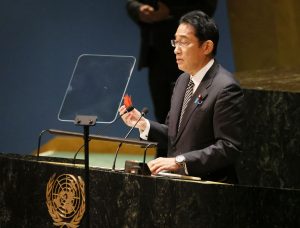On August 1, Japanese Prime Minister Kishida Fumio became the first Japanese prime minister to attend the ministerial-level review conference of the Treaty on the Non-Proliferation of Nuclear Weapons (NPT) at the U.N. headquarters in New York. Kishida had expressed a desire to attend the conference since he became prime minister last October. As a Hiroshima City-based politician, nuclear disarmament is both deeply personal and political for Kishida.
His resolve only strengthened following Russia’s invasion of Ukraine, beginning this past February, and oblique Russian threats to use nuclear strikes. During his speech to the NPT review conference, Kishida addressed the present-day dangers of nuclear weapons: “The threat to use nuclear weapons by Russia in its aggression against Ukraine has contributed to worldwide concern that yet another catastrophe by nuclear weapon use is a real possibility. We should never tolerate the threat of the use of nuclear weapons, let alone the use of nuclear weapons.”
Back in Japan, the Russian ambassador was not invited to this year’s commemoration ceremony for the atomic bombing of Hiroshima on August 6, 1945. Instead, Ambassador Mikhail Galuzin laid flowers at a memorial stone in the Peace Park a couple days early, on August 4. He was quoted as saying, “I came to show Russia’s positive attitude toward the reduction of nuclear arms.” Galuzin went as far as to say, “We [Russia] have no intention of using them [nuclear weapons]. This was not referred to directly or indirectly.”
Whatever Galuzin might believe about Russian President Vladimir Putin’s intentions, it is undeniable that the ongoing situation in Ukraine will likely make nuclear disarmament talks very difficult this year. Kishida’s decision to attend the NPT review conference went against advisers from within his own circle, who argued against his attending a conference that was unlikely to produce tangible results and could end in disarray.
Kishida acknowledged this. His speech at the conference admitted, “The path to a world without nuclear weapons has become even harder.” But he continued to say, “The NPT has served as the cornerstone of the international nuclear disarmament and nonproliferation regime in realizing international peace and security. Japan is determined to firmly uphold the NPT as its guardian.”
Kishida’s main contribution to the review conference was the Hiroshima Action Plan, which has five parts: the continued non-use of nuclear weapons; increasing transparency of nuclear capabilities; decreasing global nuclear stockpiles; promoting nuclear non-proliferation and the peaceful use of nuclear energy; and encouraging educational visits to Hiroshima and Nagasaki. In addition, Kishida also sought to build momentum toward the Comprehensive Nuclear Test Ban Treaty by proposing a meeting with leaders of Australia, Germany, and other nations on the sidelines of the U.N. General Assembly session this year. He also set up a $10 million Youth Leader Fund to encourage next-generation leaders engaging in the work of nuclear disarmament and non-proliferation to travel to Japan.
Kishida’s nuclear disarmament calendar is packed, with an international conference of political leaders planned for this November in Hiroshima to heighten momentum toward nuclear disarmament, and the G-7 summit to be held in Hiroshima next May. Kishida would like the leaders to visit the Hiroshima Peace Memorial Park and museum together at that time.
The NPT review conference, set to run until August 26, will discuss three themes: nuclear disarmament, non-proliferation, and the peaceful use of nuclear power.
Kishida previously attended the NPT review conference in 2015 as Japan’s foreign minister, the first to do so in a decade. That review conference ended with no document, as divisions between nuclear and non-nuclear powers remained deep.
This year’s review conference is the first since then, as it was delayed for two years due to the COVID-19 pandemic. If this review conference also ends without meaningful agreements, the future of the NPT as the appropriate forum for dealing with nuclear disarmament may be called into question.
Kishida also became the first Japanese prime minister to attend the Non-proliferation and Disarmament Initiative (NPDI) meeting, encouraging them to work hard to produce a meaningful outcome.
In aiming for a non-nuclear world, Kishida insists on taking a path of engagement with the nuclear powers. For example, Japan has not ratified the Treaty on the Prohibition of Nuclear Weapons (TPNW), adopted in 2017, and did not attend the first meeting as an observer. Although non-nuclear states, NGOs, and atomic bomb survivors have criticized Kishida for maintaining distance from the TPNW, he remains committed to discussions with the nuclear powers.
According to Asahi Shimbun, Kishida said “The NPT meeting is the only gathering that brings both nuclear weapon states and non-nuclear weapon states to the same table. The key will be how to persuade the nuclear powers.” As disillusioning as the path of engagement can be, he may believe there is no “realistic” alternative for Japan, which is surrounded by the nuclear powers of China, Russia, and North Korea, and protected by the U.S. nuclear umbrella.

































